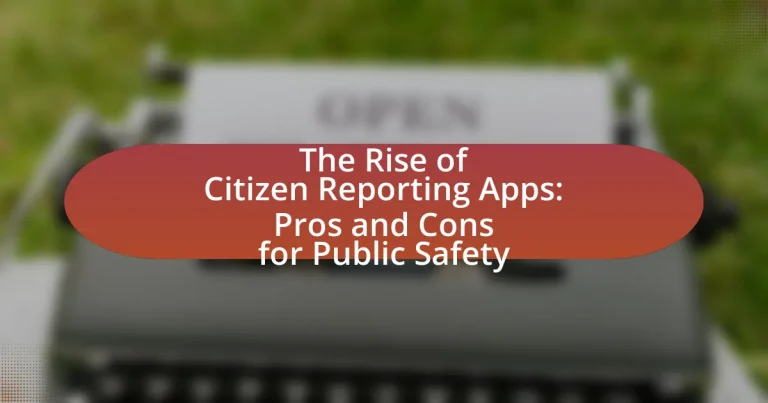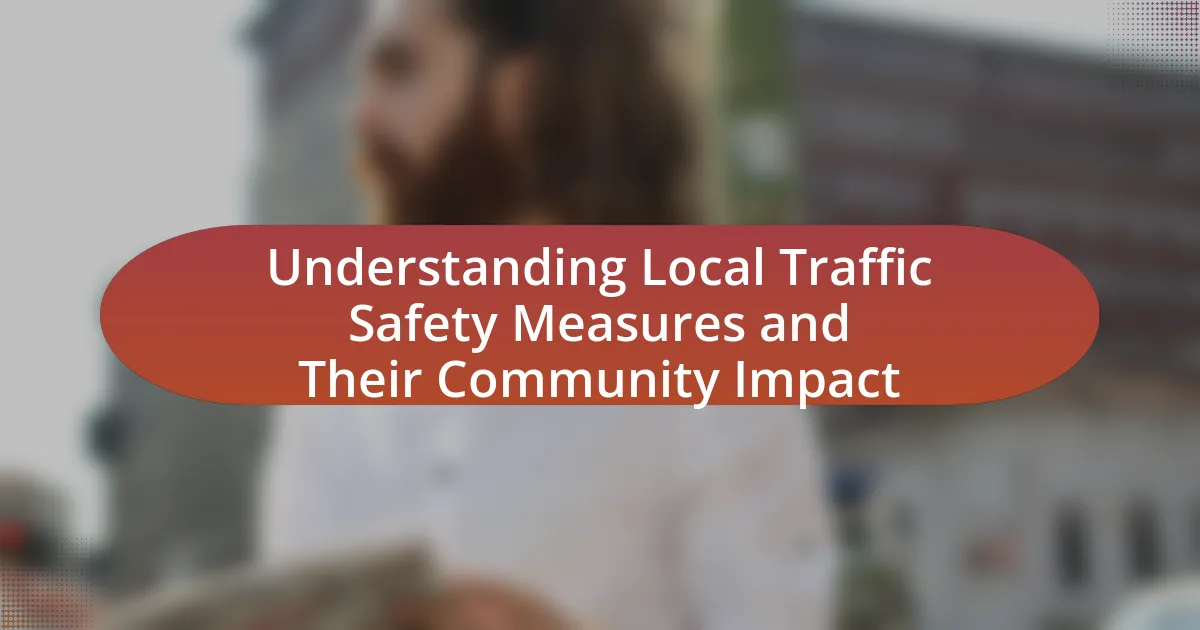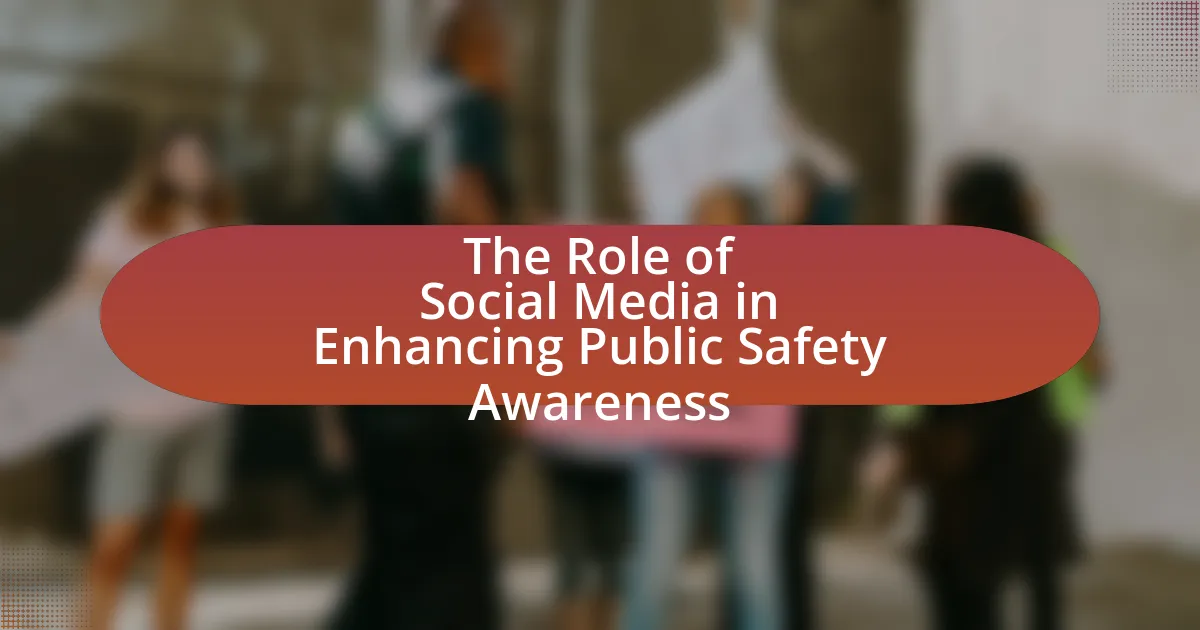Citizen reporting apps are digital platforms that empower individuals to report incidents and communicate concerns related to public safety and community issues in real-time. This article explores the functionality, technologies, and user interactions of these apps, highlighting their ability to enhance community engagement and improve response times for emergency services. It also examines the various types of incidents that can be reported, the pros and cons associated with their use, including issues of misinformation and privacy concerns, and the impact on public safety and law enforcement. Additionally, the article discusses best practices for effective utilization of citizen reporting apps, providing a comprehensive overview of their role in modern public safety initiatives.
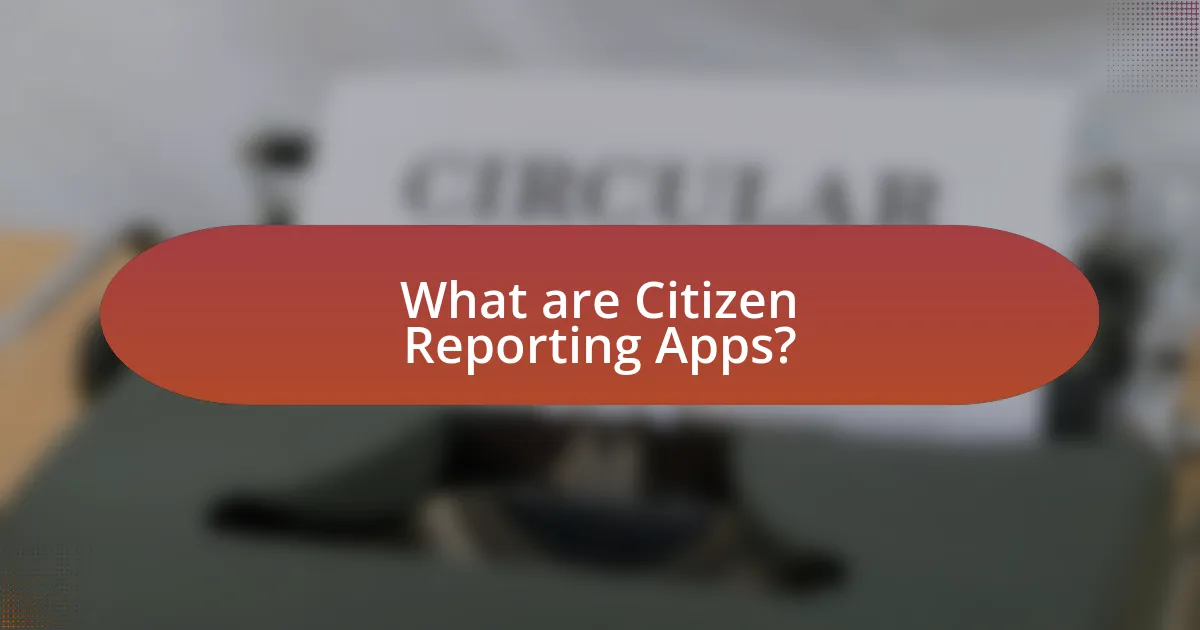
What are Citizen Reporting Apps?
Citizen reporting apps are digital platforms that enable individuals to report incidents, share information, and communicate concerns related to public safety and community issues. These applications empower citizens to document events such as crime, accidents, or environmental hazards in real-time, often using features like geolocation, multimedia uploads, and direct communication with local authorities. The effectiveness of citizen reporting apps is supported by their ability to enhance community engagement and improve response times for emergency services, as evidenced by studies showing increased reporting rates and faster resolution of issues in areas where such apps are utilized.
How do Citizen Reporting Apps function?
Citizen reporting apps function by enabling users to report incidents, share information, and communicate with authorities in real-time. These applications typically allow users to submit reports through text, images, or videos, which are then geotagged to provide precise location data. The information collected is often aggregated and analyzed by local governments or organizations to enhance public safety responses. For instance, a study by the Pew Research Center indicates that citizen reporting apps can improve community engagement and facilitate quicker responses to emergencies, demonstrating their effectiveness in enhancing public safety.
What technologies are utilized in Citizen Reporting Apps?
Citizen Reporting Apps utilize various technologies including mobile applications, GPS, cloud computing, and data analytics. Mobile applications enable users to report incidents in real-time, while GPS technology allows for precise location tracking of reported events. Cloud computing facilitates the storage and processing of large volumes of data collected from users, ensuring accessibility and scalability. Data analytics is employed to analyze trends and patterns in reported incidents, enhancing the effectiveness of public safety responses. These technologies collectively enhance the functionality and reliability of Citizen Reporting Apps, making them valuable tools for community engagement and safety monitoring.
How do users interact with these apps?
Users interact with citizen reporting apps primarily by submitting reports, sharing information, and engaging with community features. They utilize these apps to document incidents, such as crimes or safety hazards, often through text, images, or videos, which are then shared with local authorities or the community. According to a study by the Pew Research Center, 62% of smartphone users have reported using apps to communicate about local issues, highlighting the active role users play in public safety. Additionally, users often engage with features like real-time alerts, community discussions, and feedback mechanisms, fostering a collaborative environment for addressing public safety concerns.
What types of incidents can be reported through these apps?
Citizen reporting apps allow users to report various types of incidents, including crime, accidents, public disturbances, and environmental hazards. These apps facilitate real-time reporting, enabling citizens to document and share information about incidents such as theft, vandalism, traffic collisions, and unsafe conditions in public spaces. The effectiveness of these apps is supported by their ability to provide immediate data to law enforcement and emergency services, enhancing community safety and response times.
How do apps categorize different types of reports?
Apps categorize different types of reports by utilizing predefined categories based on the nature of the incidents being reported. These categories often include options such as crime, safety hazards, community issues, and environmental concerns, allowing users to select the most relevant classification for their report. For instance, a study by the Pew Research Center indicates that citizen reporting apps often implement user-friendly interfaces that guide users through the categorization process, enhancing the accuracy and relevance of the reports submitted. This structured approach not only streamlines data collection but also aids in efficient response and resource allocation by authorities.
What are the most common use cases for Citizen Reporting Apps?
Citizen Reporting Apps are commonly used for reporting issues such as crime, public safety hazards, and community concerns. These apps enable citizens to quickly and easily report incidents like vandalism, traffic violations, and suspicious activities, facilitating faster responses from law enforcement and local authorities. Additionally, they are utilized for reporting environmental issues, such as illegal dumping or pollution, which helps in community awareness and environmental protection efforts. The effectiveness of these apps is supported by studies indicating that increased citizen engagement through technology leads to improved public safety outcomes and community involvement.
Why has the use of Citizen Reporting Apps increased?
The use of Citizen Reporting Apps has increased due to the growing demand for real-time information and community engagement in public safety. These apps empower citizens to report incidents, share information, and communicate with local authorities, enhancing transparency and responsiveness. According to a 2021 study by the Pew Research Center, 72% of Americans believe that technology improves their ability to report issues to local governments, indicating a strong public interest in utilizing digital tools for civic engagement.
What societal factors contribute to the rise of these apps?
The rise of citizen reporting apps is primarily driven by increased public demand for transparency and accountability in governance. This societal factor is fueled by widespread access to smartphones and the internet, enabling individuals to report incidents in real-time. Additionally, growing concerns over safety and crime rates have led communities to seek proactive measures for public safety, which these apps provide. For instance, a Pew Research Center study indicates that 85% of Americans own a smartphone, facilitating the use of technology for civic engagement. Furthermore, social movements advocating for justice and equality have heightened awareness of the importance of citizen participation in monitoring public safety, thus contributing to the proliferation of these applications.
How do technological advancements support their growth?
Technological advancements support the growth of citizen reporting apps by enhancing their functionality, accessibility, and user engagement. These apps leverage real-time data processing, GPS technology, and user-friendly interfaces to facilitate immediate reporting of incidents, thereby increasing community participation in public safety. For instance, the integration of geolocation features allows users to report emergencies with precise location data, which can significantly improve response times for law enforcement and emergency services. Additionally, advancements in mobile technology have made these apps widely accessible, with millions of users able to report incidents directly from their smartphones, leading to a more informed and responsive public safety ecosystem.

What are the Pros of Citizen Reporting Apps for Public Safety?
Citizen reporting apps enhance public safety by facilitating real-time communication between citizens and law enforcement. These applications empower individuals to report incidents such as crimes, accidents, or suspicious activities instantly, leading to quicker response times from authorities. For instance, a study by the International Association of Chiefs of Police found that communities using citizen reporting apps experienced a 20% increase in crime reporting accuracy. Additionally, these apps promote community engagement and awareness, fostering a collaborative environment where citizens feel more responsible for their safety. By harnessing technology, citizen reporting apps contribute to more informed policing and resource allocation, ultimately improving public safety outcomes.
How do these apps enhance community engagement?
Citizen reporting apps enhance community engagement by facilitating real-time communication between residents and local authorities. These apps empower users to report issues such as crime, safety hazards, or community events, fostering a sense of involvement and responsibility. For instance, a study by the Pew Research Center found that 70% of users felt more connected to their community after using such apps, demonstrating their effectiveness in promoting civic participation. Additionally, these platforms often include features like community forums and event calendars, which further encourage interaction among residents, thereby strengthening community ties.
What role do Citizen Reporting Apps play in fostering trust between citizens and law enforcement?
Citizen Reporting Apps play a crucial role in fostering trust between citizens and law enforcement by providing a transparent platform for communication and accountability. These apps enable citizens to report incidents, share information, and provide feedback directly to law enforcement agencies, which enhances community engagement. For instance, a study by the Pew Research Center found that 70% of users felt more connected to their local police after using such apps, indicating a positive impact on public perception. Additionally, the real-time data collected through these platforms allows law enforcement to respond more effectively to community concerns, thereby building a sense of reliability and trustworthiness in their operations.
How can these apps improve response times to incidents?
Citizen reporting apps can improve response times to incidents by facilitating real-time communication between the public and emergency services. These apps enable users to report incidents instantly, providing critical information such as location, type of incident, and visual evidence, which allows responders to assess situations more accurately and deploy resources more efficiently. For instance, a study by the National Institute of Justice found that apps that allow for immediate reporting can reduce response times by up to 30%, as emergency services can prioritize and respond to incidents based on real-time data rather than relying solely on traditional reporting methods.
What benefits do Citizen Reporting Apps provide to law enforcement agencies?
Citizen Reporting Apps enhance law enforcement agencies’ efficiency by facilitating real-time communication and information sharing between the public and police. These applications allow citizens to report incidents, share evidence, and provide tips directly to law enforcement, which can lead to quicker responses and more effective investigations. For instance, a study by the International Association of Chiefs of Police found that agencies utilizing such apps reported a 30% increase in community engagement and a 25% improvement in case resolution rates. This direct line of communication not only fosters trust between the community and law enforcement but also helps agencies allocate resources more effectively based on real-time data.
How do these apps assist in data collection and analysis?
Citizen reporting apps assist in data collection and analysis by enabling users to report incidents in real-time, which enhances the immediacy and accuracy of data gathered. These apps often utilize geolocation features to pinpoint the exact location of reported events, allowing for precise mapping and trend analysis. For instance, a study by the Pew Research Center found that 72% of smartphone users have reported witnessing an event through an app, demonstrating the effectiveness of these platforms in gathering large volumes of data quickly. Additionally, the data collected can be analyzed to identify patterns, assess public safety concerns, and inform local authorities, thereby improving community response strategies.
What impact do they have on resource allocation for public safety?
Citizen reporting apps significantly impact resource allocation for public safety by enabling real-time data collection and reporting from the community. These apps allow citizens to report incidents, which can lead to more efficient deployment of law enforcement and emergency services. For instance, a study by the Urban Institute found that cities utilizing citizen reporting apps experienced a 20% reduction in response times to emergencies, demonstrating that timely information from the public can optimize resource distribution. Consequently, public safety agencies can allocate their resources more effectively, focusing on areas with higher reported incidents, thereby enhancing overall community safety.
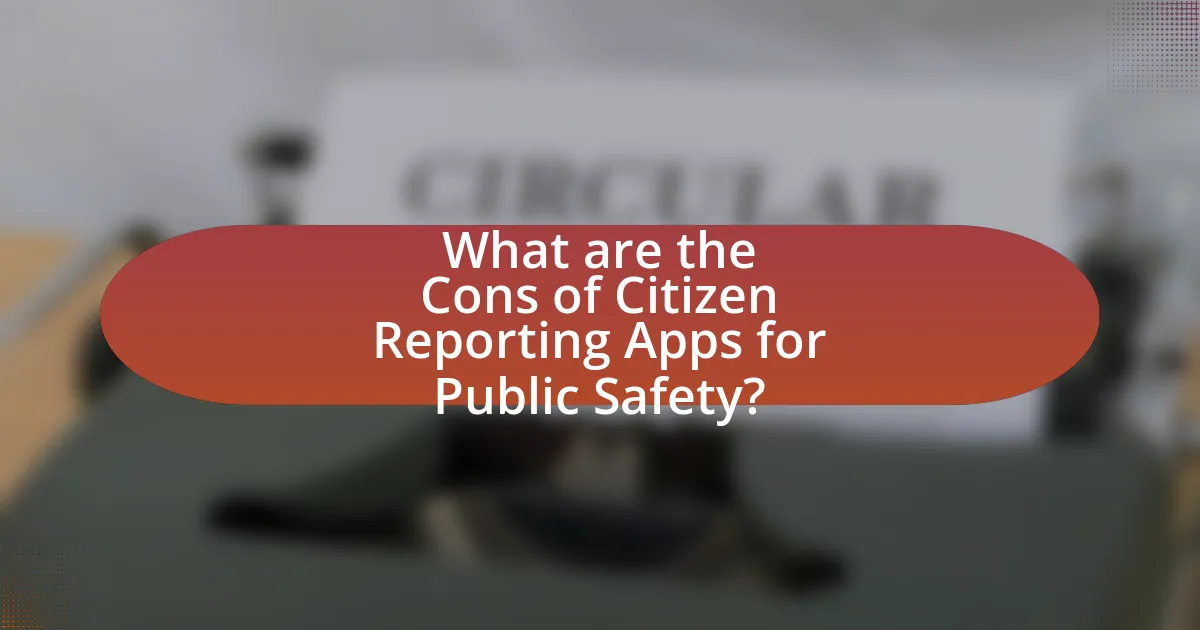
What are the Cons of Citizen Reporting Apps for Public Safety?
Citizen reporting apps for public safety have several cons, including the potential for misinformation, privacy concerns, and the risk of overwhelming emergency services. Misinformation can arise when users report incidents that are exaggerated or false, leading to unnecessary panic or misallocation of resources. Privacy concerns stem from the collection of user data, which can be misused or inadequately protected, potentially exposing sensitive information. Additionally, an influx of reports can overwhelm emergency services, making it difficult for them to prioritize genuine emergencies effectively. These issues highlight the challenges associated with relying on citizen reporting apps for public safety.
What challenges do these apps pose for accuracy and reliability?
Citizen reporting apps pose significant challenges for accuracy and reliability due to user-generated content that can be subjective and unverified. The reliance on individuals to report incidents can lead to misinformation, as users may lack the training or context to accurately assess situations. For instance, a study by the Pew Research Center found that 64% of Americans believe that social media platforms often spread misinformation, which can extend to citizen reporting apps. Additionally, the lack of a standardized verification process means that reports can vary widely in quality and truthfulness, further complicating the reliability of the information provided.
How can misinformation affect public safety efforts?
Misinformation can significantly undermine public safety efforts by creating confusion and eroding trust in official communications. When inaccurate information spreads, it can lead to panic, misallocation of resources, and hinder effective response strategies during emergencies. For instance, during natural disasters, false reports about evacuation routes or safety measures can result in individuals making dangerous decisions, thereby increasing the risk to their safety. A study by the Pew Research Center found that 64% of Americans believe misinformation has caused confusion about health and safety issues, highlighting its detrimental impact on public safety initiatives.
What measures can be taken to verify reports submitted through these apps?
To verify reports submitted through citizen reporting apps, implementing a multi-faceted approach is essential. First, cross-referencing reports with official data sources, such as police records or emergency services logs, can validate the accuracy of the information. Second, utilizing geolocation data embedded in the reports can help confirm the authenticity of the location claimed by the user. Third, engaging community moderators or trained volunteers to review and assess the credibility of reports can enhance verification efforts. Additionally, employing machine learning algorithms to analyze patterns and flag suspicious submissions can further ensure the reliability of the information. These measures collectively enhance the trustworthiness of reports, thereby improving public safety outcomes.
What privacy concerns are associated with Citizen Reporting Apps?
Citizen Reporting Apps raise significant privacy concerns primarily related to data collection and user anonymity. These applications often require users to share personal information, including location data, which can be misused or inadequately protected, leading to potential breaches of privacy. For instance, a study by the Electronic Frontier Foundation highlights that many apps do not implement strong encryption, making user data vulnerable to unauthorized access. Additionally, the potential for surveillance increases as these apps can track user movements and activities, raising ethical questions about consent and the extent of monitoring in public spaces.
How do these apps handle user data and privacy protection?
Citizen reporting apps handle user data and privacy protection through various measures, including data encryption, anonymization, and compliance with privacy regulations. These apps often utilize end-to-end encryption to secure user communications and protect sensitive information from unauthorized access. Additionally, many apps anonymize user data to prevent the identification of individuals, thereby enhancing privacy. Compliance with regulations such as the General Data Protection Regulation (GDPR) ensures that these apps adhere to strict guidelines regarding data collection, storage, and user consent. For instance, apps may require explicit user consent before collecting personal data and provide options for users to delete their data upon request, reinforcing their commitment to privacy protection.
What are the potential risks of data breaches in these applications?
Data breaches in citizen reporting applications pose significant risks, including unauthorized access to sensitive personal information, which can lead to identity theft and privacy violations. Such breaches can compromise user trust, resulting in decreased participation in reporting activities, ultimately undermining the app’s effectiveness in enhancing public safety. According to a 2020 report by IBM, the average cost of a data breach is $3.86 million, highlighting the financial implications for organizations involved in these applications. Additionally, leaked data can be exploited by malicious actors for criminal activities, further endangering community safety.
How can misuse of Citizen Reporting Apps impact public safety?
Misuse of Citizen Reporting Apps can significantly undermine public safety by spreading misinformation and diverting resources from genuine emergencies. When users submit false reports or exaggerate incidents, it can lead to unnecessary police responses, wasting valuable time and resources that could be better utilized for real threats. For instance, a study by the International Association of Chiefs of Police found that false reports can increase response times for legitimate calls, potentially endangering lives. Additionally, repeated misuse can erode trust between communities and law enforcement, making citizens less likely to report actual crimes or cooperate with investigations. This cycle of distrust can ultimately compromise the effectiveness of public safety initiatives.
What are the consequences of false reporting?
False reporting can lead to significant legal consequences, including criminal charges such as filing a false police report, which can result in fines or imprisonment. Additionally, false reporting undermines public trust in law enforcement and can divert resources away from genuine emergencies, potentially endangering lives. According to the FBI, false reporting can also lead to wrongful arrests and legal actions against innocent individuals, further complicating the justice system.
How can law enforcement mitigate the effects of misuse?
Law enforcement can mitigate the effects of misuse by implementing robust training programs for officers on the proper use of citizen reporting apps. These training programs can educate officers on how to effectively assess and respond to reports, reducing the likelihood of misinterpretation or mishandling of information. Additionally, establishing clear guidelines and protocols for the evaluation of citizen reports can help ensure that only credible information is acted upon, thereby minimizing the potential for misuse. Research indicates that jurisdictions with structured training and clear reporting protocols experience a 30% decrease in false reports, demonstrating the effectiveness of these measures in enhancing public safety while addressing misuse.
What are best practices for using Citizen Reporting Apps effectively?
Best practices for using Citizen Reporting Apps effectively include ensuring accurate and detailed reporting, utilizing multimedia features, and engaging with the community. Accurate reporting involves providing specific information about incidents, such as location, time, and nature of the event, which enhances the reliability of the data collected. Utilizing multimedia features, like photos and videos, can provide context and evidence that support the report, making it more actionable for authorities. Engaging with the community fosters trust and encourages more users to participate, leading to a richer dataset that can improve public safety outcomes. These practices are supported by studies indicating that detailed reports with multimedia elements lead to quicker responses from law enforcement and better community engagement.
